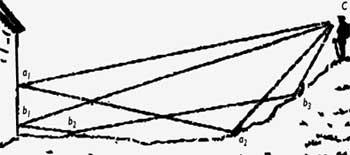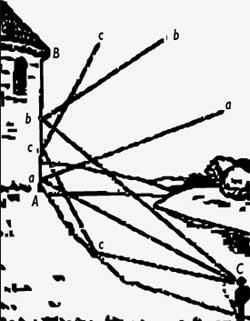Noise
Remembering this, we can easily understand the following fragment that appears in Jules Verne’s novel, “The Journey to the Center of the Earth”:
On this underground journey two men, the teacher and his nephew, are lost. Finally, they managed to get in conversation at a distance and the interview was:
- Uncle! - I screamed.
- What son? —after a while I heard
- To begin with, what is our distance?
- I don't know, but it's not hard to figure it out.
- Do you have your stopwatch?
- Yes.
- Take. Say my name and look at the exact second that marks the stopwatch when you start talking. When the sound reaches me, I will repeat the name. As soon as I hear my answer, look again at what marks the stopwatch.
- I understood it. Half the time between the signal and the response indicates the seconds necessary for the sound to reach us. Are you ready?
- Yes.
- Look! I write your name.
I put my ear against the wall. As soon as I heard the word “aksel” (my name) I repeated and stayed waiting.
- "Forty seconds," said my uncle, "so the sound has reached me in twenty seconds. As the noise emits a third of the kilometer in a second, the distance between us is about seven kilometers.”
In what was said by Julio Verne there was a miscalculation when using the speed corresponding to the air to measure the noise and in dense intervals is greater. However, we can accept it to have an approach.
Once you understand what is written in the novel, you can solve the following problem: "Old steam engines cut the perfume from a small txistu tube. The txistu of a locomotive from afar was heard a second and a half after seeing the white perfume emitted by the tube. How far was the locomotive? (since the speed of light is much higher than that of noise, we consider it infinite)."
Echo

The prestigious American writer Mark Twain shows us in a humor writing the headaches of a collector. This collector decided to make a very special collection among others, the echoes.
For this, and knowing that the echo is repeated several times in some places, he thought of buying all those places. “To begin with, he acquired a place where the repercussion of the state of Georgia was repeated four times; later another of six repetitions in Maryland; another of thirteen in Mann, an echo of nine repetitions in Kansas and finally another of twelve in Tennessee, where there was a stretch of rock defeated and that needed repair, turned out to be cheap.
The collector thought it would be easy to make a proper repair, but the architect in charge of the work had no experience and everything spoiled. Since then it is a very appropriate place to use it as a refuge for the deaf...”
All this narrated by Mark Twain is just a charm. However, on Earth there are places of great prestige to hear special echoes, most of them in the mountains.
Let's mention some of them. In England the echo in Woodstock Castle clearly repeats seventeen syllables. The echo of the castle of Derenbourg gave twenty-seven syllables, but after breaking down a wall it moved completely. If on the continent there is a group of rocks forming a circle of Adersbach in the Czech Republic and in a special area, seven syllables are repeated three times, a few steps from that area, the sound of a shot would not generate any echo.
In a castle next to Milan, today torn apart, the echo of a shot thrown from a special window was heard forty times and a word loudly thirty times. But what is echo? In fact, it is just a reflection of the sound waves emitted by us and that reach us after colliding with something. As in the case of light, the angle of incidence and the angle of reflection of acoustic rays (the sound beam is the direction of transmission of sound waves) are equal.
Let us now look at Figure 1. In it, we are at the base of a mountain (point C) and the obstacle that will reflect the noise is above, for example in AB.
The noise emitted by us will go along the lines Ca, Cb and Cc-c and after colliding with the obstacle, it will not reach our ears by the directions a, b and c, so we will not receive any echo. On the contrary, if the situation is shown in the following figure, the sound will descend following the lines Ca 1 and Cb 1 (see figure 2) and return to us once the roads Ca 1 to 2 C and Cb 1 b 2 b 3 C, generating an echo. The depth of the Earth allows the echo to be clearer, acting as a concave mirror. On the contrary, if the earth were convex, the echo would be weaker and in some cases we could not hear, since the earth's surface, like a concave mirror, would disperse the rays of sound.

You have to have an experience to find echo. Among other things, to differentiate both sounds, that is, what has been discarded and what has been reflected, should not be placed next to the obstacle and the time interval should be long so that they do not merge and become inseparable. As the noise in the air is 340 meters per second, if we are 85 meters from the obstacle, we will have to make noise and hear the echo in half a second.
Echo does not occur the same with all sounds. When the sound is very sharp and slow, the echo is usually clearer. It is best to applaud the echo. The human voice is not very suitable to generate echo, much less if it is human; the voices of children and women are more suitable for it.
Buletina
Bidali zure helbide elektronikoa eta jaso asteroko buletina zure sarrera-ontzian











